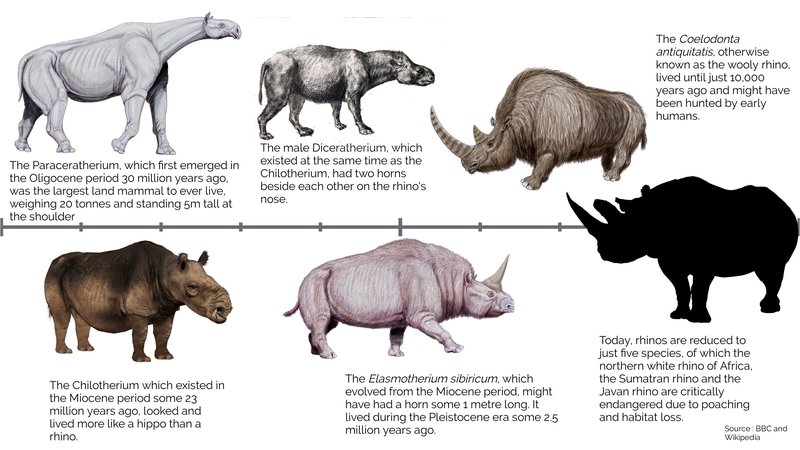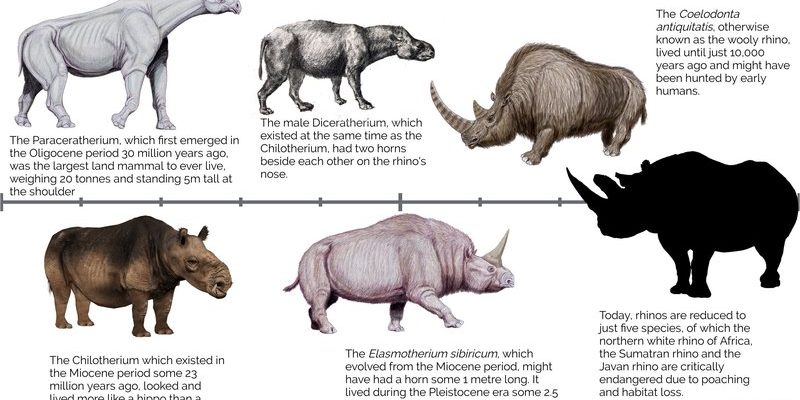
Understanding the black rhinoceros isn’t just about knowing its current plight; it’s also about appreciating how this incredible animal has adapted and evolved over time. Imagine the black rhino as a remarkable survivor in a world that’s constantly changing. They’ve managed to thrive in diverse habitats, from savannas to scrublands, while facing numerous challenges along the way. Let’s dig into their evolutionary history and see how they’ve come to be the creatures we see today.
The Origins of the Rhinoceros Family
To understand the black rhino, we must start from the beginning, millions of years ago. The rhinoceros family, known as Rhinocerotidae, evolved roughly 50 million years ago. Back then, they were quite different from the rhinos we know today. Early rhinoceroses were smaller and lived in forested areas, feeding on soft leaves and vegetation.
As time went on, these ancient rhinos adapted to various environments. Some became larger and more robust as they moved into open grasslands. They developed tough skin and powerful bodies that helped them withstand predators and environmental changes. Imagine them as the giants of their time, evolving into the formidable creatures we associate with strength and resilience.
Fast forward to about 10 million years ago, and you’ll find the ancestors of today’s black rhinos branching off. These early rhinoceroses started to diversify, adapting to different habitats and climates. This period marked a significant evolutionary leap, leading to the emergence of various species, including the black rhinoceros, which appeared around two million years ago.
The Distinction Between Black and White Rhinos
You might be surprised to learn that the black rhinoceros isn’t the only type of rhino out there. In fact, there’s also the white rhinoceros, and the two have some pretty distinct features. The main difference is size and mouth shape. Black rhinos are generally smaller, with a pointed upper lip that’s perfect for grabbing leaves and twigs from bushes. White rhinos, on the other hand, have a wide, square-shaped mouth that’s suited for grazing on grass.
While they share a common ancestor, these two species adapted to different niches in their environments. The black rhino evolved to thrive in bushy, scrubland areas where browsing is more favorable, while the white rhino became a grazer, perfectly suited to open grasslands. This divergence not only helped each species survive but also allowed them to coexist without competing for the same resources.
Interestingly, this evolutionary path highlights how species adapt to their unique environments. Imagine living in a crowded city and having to learn to navigate through traffic while also figuring out the best places to find food. That’s how black rhinos have navigated the challenges of their habitats!
Evolving Challenges: Adaptation and Survival
As we dive deeper into the evolutionary history of the black rhinoceros, it’s essential to recognize the challenges they have faced throughout time. These creatures have endured dramatic climate shifts, habitat loss, and, unfortunately, poaching. Each of these factors has played a crucial role in shaping their evolution.
During the last Ice Age, for example, many species went extinct, yet the black rhinos showed remarkable resilience. They adapted to changing ecosystems, learning to thrive in varying climates. You could picture them as the resourceful survivors, always figuring out how to make the best of their circumstances.
However, the introduction of humans has posed new threats. As human populations grew and expanded into rhino habitats, the black rhino faced increasing dangers. Poaching became a significant issue, driven by the demand for rhino horns in traditional medicine and as status symbols. This added pressure has forced black rhinos to adapt further, often retreating into more isolated and protected areas.
Modern Conservation Efforts
In recent decades, the black rhinoceros has become the focus of extensive conservation efforts. Organizations and governments worldwide have recognized the urgency of saving these magnificent creatures. Think of it like a team coming together to save a classic car model from extinction. Efforts include anti-poaching initiatives, habitat protection, and breeding programs to boost their population numbers.
One successful example is the establishment of protected reserves where rhinos can live safely away from poachers. These sanctuaries provide a controlled environment for black rhinos to thrive. Conservationists often monitor these areas closely, using technology and community involvement to safeguard the species.
Moreover, raising awareness about the importance of black rhinoceroses is crucial. Education plays a vital role in changing perceptions and reducing demand for rhino horns. Workshops and campaigns help people understand that preserving black rhinos is not just about saving an animal; it’s about maintaining biodiversity and ecological balance.
The Future of Black Rhinoceroses
Looking ahead, the future of the black rhinoceros hinges on continued efforts for conservation and a deeper understanding of their needs. As climate change presents new challenges, these rhinos must adapt once more. Their evolutionary history teaches us about resilience and the importance of protecting natural habitats.
The work isn’t done yet. We need to support conservation initiatives and advocate for policies that prioritize wildlife protection. In doing so, we can help ensure that black rhinos not only survive but thrive in their natural environments. Imagine being part of a community that helps protect these ancient creatures—it’s a rewarding cause.
Every story has its ups and downs, and the story of black rhinos is no different. They’ve weathered countless storms, and with our help, they can continue to roam the Earth for generations to come.
In wrapping up our exploration of the evolutionary history of the black rhinoceros, it’s clear these animals have a remarkable story. From their distant ancestors to their modern-day challenges, each chapter highlights the need for awareness and action. The black rhino symbolizes both the fragility and resilience of nature, serving as a reminder that every species plays a role in our planet’s rich tapestry.
By understanding their past, we can better appreciate their present and work toward a sustainable future. So, let’s commit to protecting these incredible creatures, ensuring that they don’t just survive but flourish in the wild, where they truly belong.

